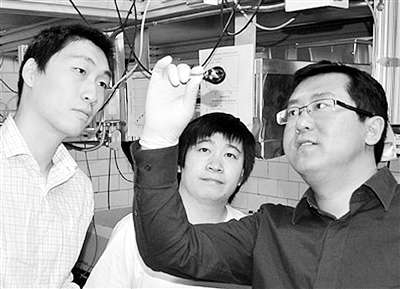 |

Since the British physicists Andrei Heim and Konstantin Novoselov succeeded in separating graphene from graphite in 2004, this magical material has attracted the interest of many scientists in the world. More attention is paid to the mechanical toughness, superior electrical and thermal conductivity characteristics of only one atom thick, honeycomb-type material.
According to a report recently organized by the Physicists Organization Network, a group of scientists from Iowa State University in the United States discovered two new properties of graphene: electron particle count inversion and broadband optical gain, which can be applied to high-speed telecommunications equipment and laser technology. on. Because graphene's ability is so "supernatural," an international team of scientists is planning to artificially create graphene, making it perform better and more perfectly.
Excited electron broadband particle inversion
Assistant Professor of Physics and Astronomy at Iowa State University and Wang Jigang, an associate researcher at the US Department of Energy's Ames Laboratory Department, led the research team to flash a very short laser pulse in graphene and immediately discovered a new one. The light excites the graphene state of electrons with broad-band particle-count reversal characteristics. Under normal circumstances, most of the electrons occupy a low-energy state, but only a few will fill the high-energy state. The opposite is true when the number of particles is inverted: more electrons fill high energy states than low energy. In nature, this inversion of the number of particles is very rare and can have very unusual properties. Thus, in graphene, the new state produces a visible infrared light gain.
Simply put, light gain means that more visible light "out" than "go in". This can only occur when using a gain medium as an external pump and then stimulated with emitted light. The researchers’ discovery opens the door to providing high-efficiency amplifiers and extremely fast optoelectronic devices in the telecommunications industry.
Wang Jingang said: "This is very exciting. Graphene is available as an optical amplification gain medium. It can be used for broadband optical amplifiers or high-speed modulators for telecommunications, and even for the development of graphene-based lasers."
The research results have recently been published in the journal Physical Review Letters.
Create a non-linear state transition
Wang Jingang believes that other scientists have studied the optical properties of graphene, but it is mainly linear. His research group can serve as a bridge to help increase understanding of the new properties of graphene to compensate for gaps in understanding of current research and to understand non-equilibrium electronic states by explaining the nonlinear optical properties of graphene.
The team's conclusions may cause graphene to form a new "specially unconventional state" that leads to population inversion and optical gain. He explained: “The linear optical properties only transmit light, an optical signal enters and exits the material, but non-linear properties can change and adjust the signal, not just the transmission, and thus provide functionality for the application of new devices. "He said:" In this regard, this is the first time that a new breakthrough has been made, and it has been observed that graphene is in a state of extremely dense electron composition, ie, a highly non-linear state. Graphene therefore has unique properties."
The research team used the high-quality graphite monolayer produced by Ames Labs and used the ultrafast laser with only 35 femtosecond short-pulse light to “excite†the electrons of the material. It was found that by measuring the photo-induced electron state, when the pulse energy pump rises above the threshold, the photoconductivity or absorbance of the graphene layer changes from the positive electrode to the negative electrode, resulting in an optical gain. The results show that in the particle inversion state, graphene is excited by light and emits much more light than it absorbs, and the absorption is negative. The researchers explained that this means that the population inversion is indeed based on the excitation of graphene and more out of the reversal medium than the light entering the basis, thus achieving the optical gain. The optical gain layer it emits is only one atom thick, and this effect requires hundreds of times the thickness if a conventional semiconductor optical amplifier is used. (Reporter Hualing Integrated Foreign Power)
Wheel Cleaner,Auto Silicone Spray,Dashboard Cleaner Spray
Fenghua Jade Motor Co., Ltd. , http://www.aerosolmp.com